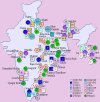Genetic structure of Indian populations based on fifteen autosomal microsatellite loci
- PMID: 16707019
- PMCID: PMC1513393
- DOI: 10.1186/1471-2156-7-28
Genetic structure of Indian populations based on fifteen autosomal microsatellite loci
Abstract
Background: Indian populations endowed with unparalleled genetic complexity have received a great deal of attention from scientists world over. However, the fundamental question over their ancestry, whether they are all genetically similar or do exhibit differences attributable to ethnicity, language, geography or socio-cultural affiliation is still unresolved. In order to decipher their underlying genetic structure, we undertook a study on 3522 individuals belonging to 54 endogamous Indian populations representing all major ethnic, linguistic and geographic groups and assessed the genetic variation using autosomal microsatellite markers.
Results: The distribution of the most frequent allele was uniform across populations, revealing an underlying genetic similarity. Patterns of allele distribution suggestive of ethnic or geographic propinquity were discernible only in a few of the populations and was not applicable to the entire dataset while a number of the populations exhibited distinct identities evident from the occurrence of unique alleles in them. Genetic substructuring was detected among populations originating from northeastern and southern India reflective of their migrational histories and genetic isolation respectively.
Conclusion: Our analyses based on autosomal microsatellite markers detected no evidence of general clustering of population groups based on ethnic, linguistic, geographic or socio-cultural affiliations. The existence of substructuring in populations from northeastern and southern India has notable implications for population genetic studies and forensic databases where broad grouping of populations based on such affiliations are frequently employed.
Figures



References
-
- Singh KS. India's Communities People of India National Series. IV. India: Oxford University Press; 1998.
-
- Gadgil M, Joshi NV, Shambu Prasad UV, Manoharan S, Patil S. Peopling of India. In: Balasubramanian D, Rao NA, editor. The Indian human heritage. Hyderabad, India: Universities Press; 1997. pp. 100–129.
Publication types
MeSH terms
LinkOut - more resources
Full Text Sources

